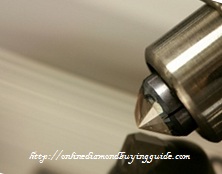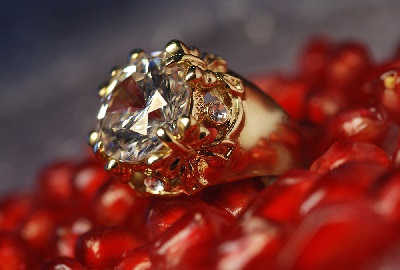Glossary of Terms ( A – C )
Click here to view diamond glossary terms: D – L or M – Z
Alluvial Mining – one of the two major ways of diamond mining (for the other, see pipe mining). Alluvial mining involves the extraction of rough stones from secondary deposits in riverbeds.
Appraisal – written estimations regarding the worth or value of a piece of jewelry. Appraisals can be used for both retail and insurance purposes.
Annealing – process for color treating a diamond through heating. Effects are usually permanent in nature.
Artisanal Mining – one of the simpler variations of alluvial mining (see above). This is very similar to the way gold diggers used to search for nuggets on the banks of rivers. Artisanal mining is usually done by individuals or by small groups of people using primitive hand tools.
Bearded Girdle – Tiny feather inclusions that extend from the inside the diamond to the surface of the stone at the girdle. Usually a result of the a bad bruting process.
Bezel – one of the 8 main facets on the crown of a brilliant cut diamond. Also known as kite facets.
Blemish – inclusions that do not penetrate the surface of the diamond. Obviously, these are less harmful types of imperfections which can be removed by minor re-polishing. Blemishes also form from sediments of foreign material on the surface of diamonds.
Botswana – a country from southern Africa. It is by far the most significant source of rough, uncut diamonds in both value and volume. Recently formed a partnership with De Beers called Debswana.
Brilliant Cut – the brilliant cut is probably the most well-known facet arrangement used for diamonds. In this arrangement, facets all seem to radiate outwards from the table of the diamond in a way that maximizes brilliance. Typically, the shape of the facets are kite or triangular. Some of the fancy shapes that apply a brilliant cut arrangement include princess, ovals, round, hearts, marquises and many others.
Carat – one of the famous “four C’s” of diamonds. Carat represents the weight of a diamond. Semantically derived from the carob bean which has historically been used to measure gem stones, one carat equals 200 milligrams and can be divided into 100 points.
Chip – An opening due to damage to the stone’s surface. These are usually shallow and occur at the pointed edges of facet junctions. The difference of a chip from a cleavage lies in its somewhat rounded outline. Areas prone to chipping are the tips of fancy cuts and the culet where the pavilion mains meet.
Cut – the fourth of the “four C’s”, it describes the totality of different ratios and angles in a diamond. The overall cut grade is usually assigned in consideration of the finish on the stone too. It can be considered the most significant of the “four C’s”. Cutting involves the most human interaction and biggest factor that can affect the overall beauty of a diamond.

Cutter – the professional who cuts and polishes the rough diamond so that it will be ready to hit the market as a bright sparkling stone.
Cavity – a surface reaching type of inclusion that can be caused by many reasons. They form when an interior feather breaks the surface or during polishing where a crystal drops out of its location, leaving a void in place.
Clarity – another key determinant of quality in the “four C’s”. Clarity grading denotes the amount of inclusions and blemishes on the inside and on the surface of diamonds based on many other modifying factors like location and relief. Ideally, diamonds should contain no inclusions or blemishes whatsoever.
Cloud – an area inside the diamond that contains a group of microscopic inclusions. These microscopic inclusions can be colored or transparent and their densities may vary. Typically forms a cloud looking shape and hence the given name.
Color – yet another one of the “four C’s”. Color denotes the material quality of the stone. Ideally speaking, a diamond should be colorless. If a stone receives a color grading lower than K, the type of tint (e.g. yellow or brown) is indicated on the grading report.
Crown – the part of a diamond which is situated above the girdle.
Crown Angle – the angle between the crown facet of the diamond and its girdle.
Crown Jewels – these have nothing to do with the crowns of individual diamonds. Crown Jewels are collections of diamonds and other jewelry belonging to the royal family of a certain country. When it comes to crown jewels, we usually associate jewelry own by the royalty in France or the United Kingdom.

Crystal – an inclusion that is found within the body of the diamond. They could be embedded minerals or even diamonds that are left inside the diamond during formation.
Culet – the bottom-most facet of a cut diamond. Culets are placed on the diamond for the sole purpose of protecting the tip from chipping. When there is no culet present, the diamond is described as having no culet or having a pointed culet.
Click here to find definition of terms in the alphabetical order: D – L or M – Z







